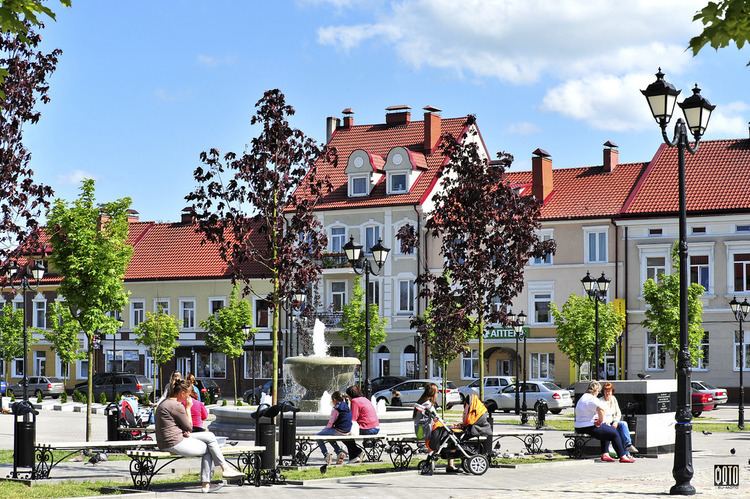Administrative district Gvardeysky District Urban okrug Gvardeysky Urban Okrug Local time Sunday 10:56 AM | Town of district significance Gvardeysk Area 12 km² | |
 | ||
Weather 2°C, Wind NE at 8 km/h, 86% Humidity | ||
Gvardeysk (Russian: Гвардейск; [ɡvɐrˈdʲejsk]), known prior to 1946 by its German name Tapiau (Lithuanian: Tepliava; Polish: Tapiawa/Tapiewo), is a town and the administrative center of Gvardeysky District in Kaliningrad Oblast, Russia, located on the right bank of the Pregolya River 38 kilometers (24 mi) east of Kaliningrad, the administrative center of the oblast. Population: 13,899 (2010 Census); 14,572 (2002 Census); 11,904 (1989 Census).
Contents
- Map of Gvardeysk Kaliningradskaya Oblast Russia
- History
- Administrative and municipal status
- Coat of arms
- Sights
- People
- References
Map of Gvardeysk, Kaliningradskaya Oblast, Russia
History
Peter of Dusburg wrote of a settlement known as Tapiow, first documented in 1254, and the neighboring fort Surgurbi built by 1265. The Old Prussian names were derived from the words tape, teplu, toplu, tapi, meaning "warm", and sur garbis, meaning "around the mountain". During the 13th century Prussian Crusade, the area was conquered by the Teutonic Knights. To protect Samland from the Nadruvians and Scalvians, the crusaders built a wooden fort between the Deime and Pregel Rivers in 1283–1290. This was replaced by Tapiau Castle, a stone Ordensburg, in 1351.
The settlement gradually became known by the German crusaders as Tapiau. Vytautas, the later Grand Duke of Lithuania, was baptized in Tapiau in 1385. After the transfer of the Grand Master's seat from Marienburg to Königsberg, Tapiau became the site of the Order's archives and library from 1469 to 1722.
Tapiau became a part of the Duchy of Prussia in 1525. The Tapiau Castle was often used as a second residence of the Prussian dukes; Albert of Prussia died there in 1568. It became a part of the Kingdom of Prussia in 1701, receiving town privileges from King Frederick William I of Prussia in 1722. It was a part of the Prussian Province of East Prussia and was administered in Landkreis Wehlau (1818–1945). Tapiau became a part of the German Empire during the unification of Germany in 1871.
Unlike most other towns in northern East Prussia, Tapiau was largely undamaged during World War II. Following the war's end in 1945, it was annexed by the Soviet Union and renamed Gvardeysk ("guard town") in 1946. Of the town's German population of more than 9,000, those who had not fled or been killed in the final months of the war were expelled and gradually replaced by Soviet settlers.
Administrative and municipal status
Within the framework of administrative divisions, Gvardeysk serves as the administrative center of Gvardeysky District. As an administrative division, it is, together with one rural locality (the settlement of Prigorodnoye), incorporated within Gvardeysky District as the town of district significance of Gvardeysk.
Within the framework of municipal divisions, since June 11, 2014, the territories of the town of district significance of Gvardeysk and of four rural okrugs of Gvardeysky District are incorporated as Gvardeysky Urban Okrug. Before that, the town of district significance was incorporated within Gvardeysky Municipal District as Gvardeyskoye Urban Settlement.
Coat of arms
The coat of arms of Gvardeysk depicts a bare hand holding a sword amongst clouds, beneath a golden sun. When the town was known as Tapiau before 1946, the golden sun also included the Tetragrammaton (Jehova-Sonne).
Sights
Sights of Gvardeysk include a church from 1502 and the ruined Tapiau Castle, reconstructed into an orphanage in 1879. It has been used as a prison since 1945.
People
Tapiau's most famous resident was the German Impressionist painter Lovis Corinth (1858–1925), who donated the painting Golgatha for the altar of the town's church in 1910; the painting disappeared near the end of World War II. The house where Corinth was born still stands in Gvardeysk. Other notable people associated with the town include Albert, Duke of Prussia (1490–1568), who died in Tapiau.
